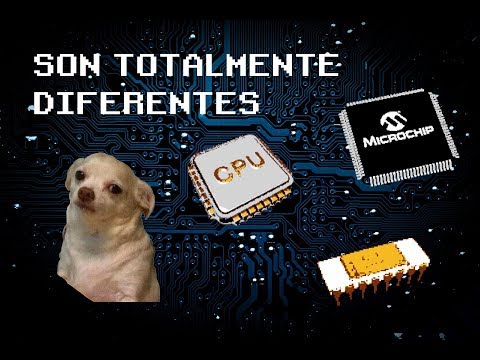Transistor vs. Microprocessor: How are they different?
Hello to all lovers of electronics and programming! If you are here it is because you are inveterately curious like us, and you are passionate about discovering the differences between the most important electronic components. In the world of electronics, there are two components that are absolutely essential: the transistor and the microprocessor. Both are essential for the operation of any electronic device, but do you really know what their differences are? Today we are going to delve into this topic and discover together everything you need to know about transistor vs. microprocessor. Let us begin!
Understanding the key differences between transistors and microprocessors in electronics.
Transistor vs. Microprocessor: How are they different?
Transistors and microprocessors are two fundamental components in the world of electronics. Although both are important, they have very different characteristics. Below are the key differences between both components:
Transistors:
Transistors are electronic devices used to amplify or switch electrical signals. These components are the basic building blocks of electronic circuits. Transistors can be of different types, such as bipolar transistors, field effect transistors (FET), and metal-oxide-semiconductor field effect transistors (MOSFET).
Transistor characteristics:
– They are passive devices that do not process information.
– They are analog components.
– They have a single function: amplify or switch electrical signals.
– They are used to build complex electronic circuits.
Microprocessors:
Microprocessors, also known as CPU (Central Processing Unit), are electronic components that process information and execute instructions in a computer. Microprocessors are made of millions of transistors connected together.
Characteristics of microprocessors:
– They are active devices that process information.
– They are digital components.
– They have multiple functions, such as text processing, graphics, sound, video, etc.
– They are used in computers and other electronic devices.
Key differences between transistors and microprocessors:
Below is a table that summarizes the main differences between transistors and microprocessors:
| Transistors | Microprocessors |
|---|---|
| Passive devices | active devices |
| Analog components | Digital components |
| single function | Multiple functions |
| They are used to build electronic circuits | They are used in computers and other electronic devices |
In summary, transistors and microprocessors are important electronic components but very different in terms of their characteristics and functions. Transistors are passive, analog devices used to build electronic circuits, while microprocessors are active, digital devices used in computers and other electronic devices to process information and execute instructions.
The brain of technology: Understanding the role of the microprocessor and its link with transistors
Transistor vs. Microprocessor: How are they different?
Transistors and microprocessors are two fundamental components of modern technology. However, although both are related, they have significant differences. Here we explain some of them:
Transistor:
– It is an electronic component that is used to amplify or switch electrical signals.
– It was invented in 1947 by physicists John Bardeen, Walter Brattain and William Shockley from Bell Laboratories.
– It is the basic component of modern electronics, since it is used in the manufacture of integrated circuits, which in turn are used in almost all electronic devices.
– Transistors are small, typically less than 1 cm wide, and are manufactured in large quantities in semiconductor manufacturing processes.
Microprocessor:
– It is an integrated circuit that contains the central processing unit (CPU) of a computer.
– It was invented in 1971 by the Intel Corporation.
– It is the brain of the computer, since it is responsible for processing information and executing program instructions.
– Microprocessors are much larger than transistors, generally several centimeters wide, and are manufactured in smaller quantities.
Comparison chart:
| Transistor | Microprocessor |
| ———- | ————— |
| Amplifies or switches electrical signals | Contains the central processing unit (CPU) |
| Invented in 1947 | Invented in 1971 |
| Basic component of modern electronics | Computer brain |
| Small (usually less than 1cm wide) | Large (usually several centimeters wide) |
| Manufactured in large quantities | Manufactured in smaller quantities |
In summary, although transistors and microprocessors are fundamental components of modern technology, they have different roles. Transistors are used to amplify or switch electrical signals, while microprocessors are the brain of the computer and are responsible for processing information and executing program instructions.
Understanding the differences between microprocessors and microcontrollers in electronics
Understanding the differences between microprocessors and microcontrollers in electronics
Microprocessors and microcontrollers are two very common terms in electronics, but how are they different? Below are the main differences:
Microprocessors:
- Microprocessors are chips that are responsible for processing data in a system.
- They are designed to process large amounts of information in a short period of time.
- Microprocessors do not have memory or integrated inputs/outputs, so they require other components to function.
- Microprocessors are used in systems that require a large amount of data processing, such as personal computers, servers, and industrial process control systems.
Microcontrollers:
- Microcontrollers are chips that combine a microprocessor, memory, and integrated inputs/outputs into a single package.
- They are designed for systems that require simpler data processing and greater interaction with external devices.
- Microcontrollers are used in systems that require precise control of external devices, such as temperature control systems, security systems, and lighting control systems.
In summary, microprocessors are best suited for systems that require a large amount of data processing, while microcontrollers are best suited for systems that require precise control of external devices.
While both have specific applications, it is important to understand the differences between them so you can choose the right component for each system.
| Microprocessors | Microcontrollers | |
|---|---|---|
| Integrated | Processor only | Integrated processor, memory and inputs/outputs |
| Applications | Computers, servers and industrial process control systems | Temperature control systems, security systems and lighting control systems |
| Data processing | High quantity in short period of time | Simpler data processing |
The importance of transistors in microprocessors: everything you need to know.
Transistor vs. Microprocessor: How are they different?
Before delving into the importance of transistors in microprocessors, it is important to understand the difference between these two key components of electronics.
Transistor: A transistor is a semiconductor device used to amplify and switch electronic signals. It is one of the most important components of modern electronic circuits.
Microprocessor: A microprocessor is a chip that contains millions of transistors and is the brain of a computer.
It is responsible for executing instructions and performing calculations.
The importance of transistors in microprocessors:
1. Transistors are the basis of microprocessors: As mentioned above, microprocessors are made up of millions of transistors. Without them, microprocessors could not exist.
2. Transistors allow miniaturization: Transistors are very small and can be manufactured in large quantities on a single chip. This allows the miniaturization of microprocessors and their integration into increasingly smaller devices.
3. Transistors allow for greater speed: Transistors allow switching and signal amplification operations to be performed at incredibly fast speeds. This allows microprocessors to execute instructions and perform calculations at very high speeds.
4. Transistors allow for greater energy efficiency: Transistors can be designed to consume very little energy when not in use. This allows microprocessors to be more energy efficient and extend battery life in portable devices.
The evolution of transistors in microprocessors over the years
Transistor vs. Microprocessor: How are they different?
Transistors and microprocessors are two fundamental components in modern electronics. Transistors are the fundamental building blocks of electronic circuits and microprocessors are the brains of modern electronic devices. Next, we will see the evolution of transistors in microprocessors over the years.
1. First generation transistors
The first generation transistors were manufactured in the late 40s and early 50s. These transistors were made from germanium and were used in radios and other electronic devices of the time. These transistors were large and bulky and required a lot of space to manufacture.
2. Second generation transistors
Second generation transistors were manufactured in the late 50s and early 60s. These transistors were made from silicon and were used in calculators and other electronic devices of the time. These transistors were smaller than the first generation and required less space to manufacture.
3. Third generation transistors
Third generation transistors were manufactured in the late 60s and early 70s. These transistors were made from silicon and were used in early microprocessors. These transistors were even smaller than the second generation and required less space to manufacture.
4. Fourth generation transistors
Fourth generation transistors were manufactured in the late 70s and early 80s. These transistors were made from silicon and were used in the first commercial microprocessors. These transistors were even smaller than the third generation and required less space to manufacture.
5. Fifth generation transistors
Fifth generation transistors were manufactured in the late 80s and early 90s. These transistors were made from silicon and were used in microprocessors of the time. These transistors were even smaller than the fourth generation and required less space to manufacture.
6. Sixth generation transistors
Sixth generation transistors were manufactured in the late 90s and early 2000s. These transistors were made from silicon and were used in microprocessors of the time. These transistors were even smaller than the fifth generation transistors and required less space to manufacture.
7. Seventh generation transistors
Seventh-generation transistors were manufactured in the late 2000s and early 2010s. These transistors were made from advanced semiconductor materials and were used in microprocessors of the time. These transistors were even smaller than the sixth generation and required less space to manufacture.
In summary, the evolution of transistors in microprocessors has been constant over the years. Each new generation of transistors has allowed the creation of faster, smaller and more efficient microprocessors. Today, microprocessors are made with advanced transistors that are smaller than the wavelength of visible light and are manufactured using specialized lithography techniques.
In summary, the transistor and the microprocessor are essential components in electronics and programming. Both have different but equally important functions in the world of technology. So don't choose one over the other, but enjoy both and keep learning about them!



Post Comment